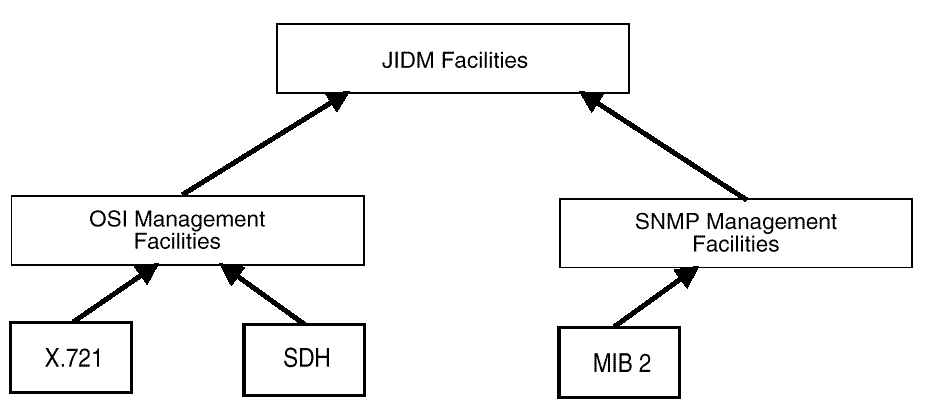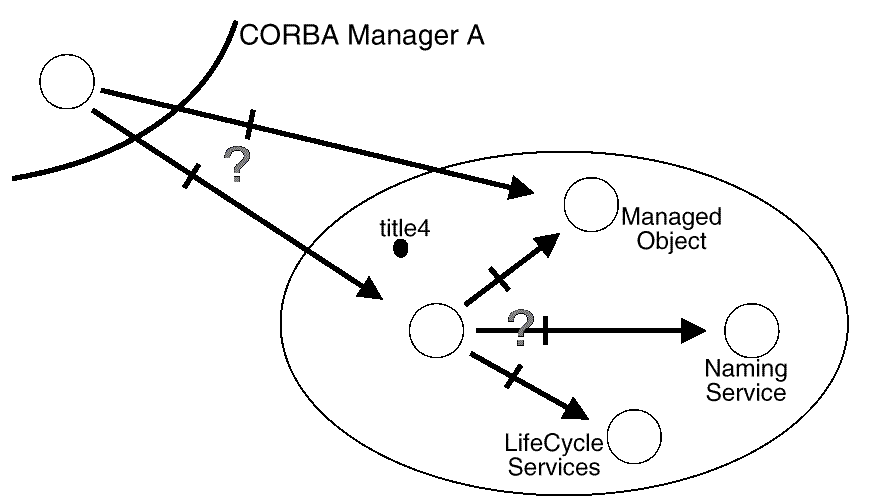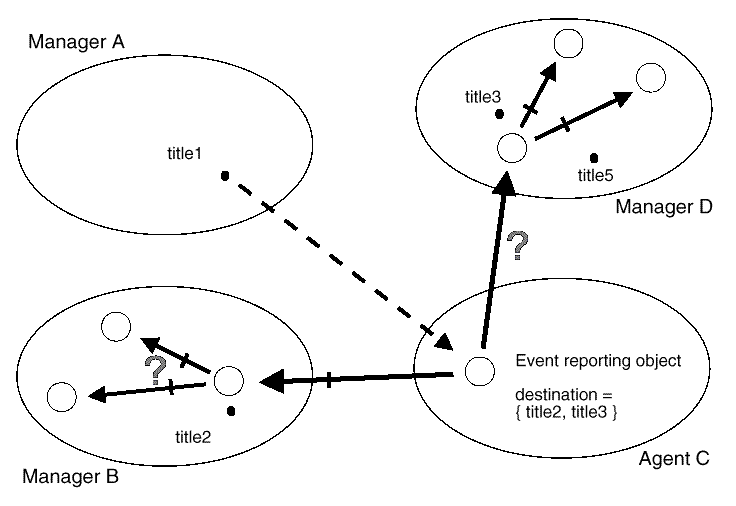Previous section.
Book 2: Inter-Domain Management: Interaction Translation (JIDM_IT)
Copyright © 1999 The Open Group
Introduction
Reference Model
To enable interworking between management systems based on different
technologies, it is
necessary to be able to map between the relevant object models and to
build on this to provide
mechanisms to handle protocol and behaviour conversions on the domain
boundaries.
In order to be able to interwork between a particular pair of
management reference models,
there are two aspects that need to be defined:
-
A translation scheme between the different object models of both
management reference
models. This is referred to as
Specification Translation.
-
A dynamic conversion mechanism between the protocols and behaviours
used in both
domains. This is referred to as
Interaction Translation.
This allows objects in one domain to be represented in the other
domain, and the interactions
are governed by the domain of choice rather than by the domain in
which the target object
is implemented. In addition, this is achieved done without either party
being aware of the conversion.
This document presents a set of facilities to provide interoperability
between CORBA and
alternative telecommunication management models, specifically OSI
management and Internet
management. As described above, two aspects need to be defined:
Specification Translation and Interaction Translation
Specification Translation
The translation scheme is defined in
Book 1
of this document.
The definitions in this Interactive Translation
Book 2
fully support the
associated Specification Translation
Book 1.
Interaction Translation
This document presents a set of CORBA facilities required to support
interworking with different
management environments. Together, these are referred to as
JIDM Interaction Translation.
There are three levels of interfaces being defined:
-
Generic interfaces, management model independent
These facilities
provide a generic
framework to access a managed domain, independently of the management
reference
model being used. These generic facilities are referred to as JIDM
Facilities, and are described in
JIDM Facilities.
-
Generic interfaces, management model specific
Two management
reference models are
considered - OSI Management, and Internet Management (SNMP):
-
OSI Management Facilities,
presented in
OSI Management Facilities,
provide a CORBA view of the
OSI Management reference model, as described in the relevant ITU-T and
ISO documents
(see, among others, references
X720
and
M3010).
This set of facilities extends the
generic JIDM Facilities to support all CMIS interactions in CORBA, and
to support
OSI specific concepts such us scoping, filtering and multiple replies
both in pure
CORBA environments and in interworking environments (gateways).
-
SNMP Management Facilities,
presented in
SNMP Management Facilities,
provide a CORBA view of the
Internet Management reference model. This set of facilities also
extend the generic
JIDM Facilities to support all SNMP interactions in CORBA, and to
support Internet specific concepts.
-
Specific interfaces, information model and management model dependent
These interfaces
provide functionality that is specific to a given information model,
that conforms to
a certain management reference model. These interfaces reuse and
extend the generic
CORBA facilities of the corresponding management reference model (OSI
Management
or SNMP Management facilities) in an information model-specific way.
In case the specific
information model is specified in a foreign specification language
(GDMO/ASN.1
for OSI management, SNMP SMI for Internet management), the equivalent
CORBA IDL
model may be automatically generated by following the translation
algorithms defined in reference
JIDM_ST.
Note that it is
possible to specify an information model directly using CORBA IDL, and
yet reuse the
OSI management or SNMP management facilities.
It is beyond the scope of this Interaction Translation specification
to specify any information model-specific interfaces.
However, the mechanisms to specify such interfaces, as well as a
generic set of
algorithms to translate existing information models, are specified.
There is a dependency between these three types of interfaces, as
shown in
JIDM Facilities.

Figure: JIDM Facilities
Basic Concepts
There are certain words and concepts used throughout this document
where the use of that word or concept is very specific.
This section defines the special meanings
attributed to these words/concepts.
A distributed management system is composed of two kinds of entities:
manager entities and managed entities.
Manager entities
are those that have responsibility for one or more
management activities,
by issuing management operations and receiving notifications. They are
the components
exploiting the behaviour provided by implementations of a given
information model.
Managed entities
are those that have responsibility for certain
underlying resource(s). They
perform management operations issued by manager entities on the
underlying resources, and
emit notifications whenever some specific circumstances occur. They
are the components
implementing the behaviour of a given information model.
In object oriented systems, these abstract entities are materialized
in the form of specific
objects. Therefore the terms
manager object
and
managed object
can be considered synonymous of the above in object oriented systems.
Manager objects (entities) are said to act in the
manager role,
while managed objects (entities)
are said to act in the
agent role.
These objects (entities) are grouped into
domains,
according to some specific grouping criteria.
Domains are considered the unit of accessibility, therefore being the
independently
addressable components within a distributed system; each domain (both
manager and managed)
may have any number of objects within it.
Managed domains are sometimes referred to as
agents
and
managed object domains,
while manager domains are sometimes referred to as
manager applications
or simply
managers.
Domains are identified by using
titles.
Each domain may have an arbitrary number of titles
associated with it, but a title uniquely identifies one domain.
Whenever a manager or an agent needs to interact with an agent or
manager (respectively), it
must first gain access to the other domain. This access is always
granted though an specific
port to the domain. Each port is uniquely identified by one of the
titles associated to the
domain being accessed.
Specifically, two types of ports are identified:
-
When access to a domain is required in order to be able to create
and/or invoke operations
on managed objects within the domain, the port is called
domain port.
-
When access to a domain is required in order to be able to forward
events to manager
objects within the domain, the port is called
event port.
When a manager (agent) gains access to a managed object domain
(manager domain), it is said that a
session
has been established. That session may be
released, meaning that no
further exchange of information may happen, because access has been
revoked.
Any number of sessions may exist between a manager and an agent at any
given time.
Design Objectives
Invoking Operations on Managed Objects
CORBA Facilities need to be defined that allow CORBA manager objects
to connect to Managed
Object Domains given their titles. Additional CORBA Facilities need to
be defined that
allow a CORBA manager object (that is connected to some given domain
of managed objects) to:
-
Create a new member of the domain (a new managed object) and assign
a name to it.
-
Obtain a reference to a member of the domain (an existing managed
object) given its name.
-
Operate on collections of those members of the domain which meet
some criteria (for example,
descendants of some managed object which pass some specific filter,
etc.).
A complete solution requires explaining how these CORBA Facilities
will interact with Naming
and LifeCycle Object Services at CORBA Managed Object Domains. These
questions are represented in
Invocation of Management Operations.

Figure: Invocation of Management Operations
A fundamental requirement for definition of such CORBA Facilities is
that the specific management
protocol (CMIP, SNMP, CORBA IIOP, etc.) being used to get access to a
Managed
Object Domain and operate upon managed objects located there, must be
totally transparent
to CORBA manager objects and CORBA managed objects.
Event reporting
A CORBA Manager will have at least one title associated with it. This
title permits it to be
identified as a destination for event reporting. CORBA Facilities need
to be defined that allow:
-
Events reports emitted by CORBA managed objects to be reported to
specific CORBA
Managers that have been designated by their titles.
-
CORBA Manager objects to be notified about events reported from
remote Managed Object Domains.
A fundamental requirement for definition of such CORBA Facilities is
that the specific management
protocol (CMIP, SNMP, CORBA IIOP, etc.) being used to report an event
must be
totally transparent to CORBA manager objects and CORBA managed
objects.

Figure: Event reporting
When solving the problem of event reporting, the following scenarios
must be considered:
-
One manager application must be able to change the list of
destinations (titles) to which
event reports emitted by managed objects in a managed object domain
are being
reported. In the OSI environment, this will be accomplished by means
of changing the
destination attribute value of an EFD object that is member of the
managed object
domain being considered.
-
One manager application may spontaneously start receiving event
reports from a remote
managed object domain due to a decision taken by a third party
(another manager application)
who has changed the list of destinations for event reports associated
to the managed object domain.
Why not acquire a nicely bound hard copy?
Click here to return to the publication details or order a copy
of this publication.



